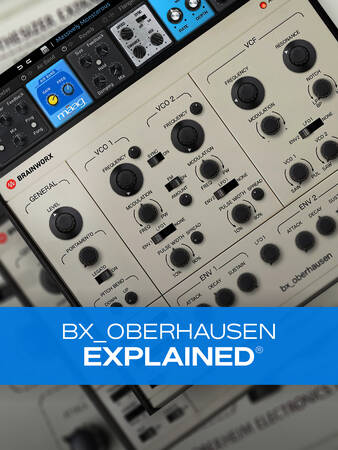Groove3 bx_oberhausen Explained TUTORiAL

Groove3 bx_oberhausen Explained | 171.00 MB
Download Groove3 bx_oberhausen Explained
Join synth expert Larry Holcombe for a look at Brainworx’s bx_oberhausen, the company’s first virtual instrument that uses TMT (tolerance modeling technology) to emulate the famous Oberheim SEM (Synthesizer Expander Module) from the 1970s and build upon it. In the bx_Oberhausen video course, you’ll learn all about the oscillators, filters, envelopes, and everything else that lends this synth its unique sound, as well as hear it in action with many different examples. By the end of this Oberhausen course, you’ll be ready to start using it on your very next track! These Oberhausen videos are designed for new bx_oberhausen users.
Larry begins by welcoming you and briefly discussing the instrument in general terms, so you know a little history about the original and what it can do. This is followed by a tour of the interface, so you’ll know your way around the synth before diving in. Then it’s on to the oscillators, where you’ll learn about the available waveforms, sync and FM modes, stereo spread control, pitch, and pulse width modulation.
Next, you’ll explore the filter section and hear its distinctive character along with the mid/side feature, with which you can route only the mid or side signals through the filter. The modulators, including the envelopes and LFO, are covered next, both of which can be used to shape the sound over time.
There’s plenty more to see as well, including the General section (global level control, play modes, portamento, etc.), FX section (six effects available), Arpeggiator (different playback modes, clock and swing control, etc.), Modulation section (setting up various routings), Toolbar menu (presets, MIDI learn, etc.), and more. The course wraps up with Larry showing you how to create two great-sounding patches from scratch: Experimental Drums and Dark Pad.
The bx_oberhausen faithfully recreates the legendary sound of the Oberheim SEM while also updating it with 32-note polyphony, nine modulation routing sources, and more. In order to fully get all these features under your fingers, you need to watch this Oberhausen video course. A synth is only as capable as its user, so why not get the most out of it? Check out the individual bx_oberhausen video tutorial descriptions for more information on the contents of each and the capabilities of this instrument. Synth glory awaits… Watch “bx_oberhausen Explained®” now!
What You Will Learn:
-Interface layout and basic capabilities
-Selecting oscillator waveforms and using stereo spread, pitch detuning, and pulse width modulation
-How to use mid/side processing with the filter
-Routing modulation from any sourc
- Click ” Download Now ” Button For Download Your File



